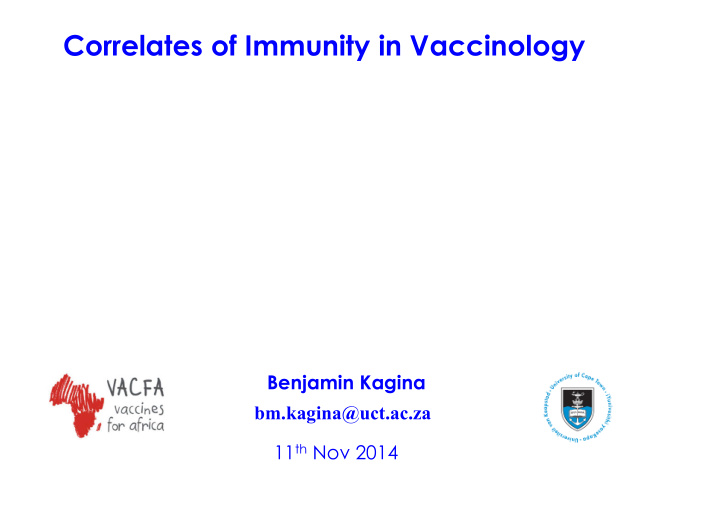



Correlates of Immunity in Vaccinology Benjamin Kagina bm.kagina@uct.ac.za 11 th Nov 2014
Correlates of Immunity in Vaccinology 1) Vaccine development 2) Vaccine evaluation
Vaccine evaluation Pre-licensing (phase I-III) Post-licensing (phase IV) Vaccine efficacy: Vaccine effectiveness: -% reduction in disease -Protective ability of a incidence (vaccinated Vs vaccine towards the unvaccinated) groups target disease/outcomes of interest in real life situations -under optimal conditions (eg RCT)
Vaccine efficaccy = ARU-ARV/ARU x 100 Vaccinated ARV = 2/10 = 0.2 Unvaccinated ARU = 9/10 = 0.9 0.9 – 0.2 = 78% Efficacy = 0.9
Vaccine effectiveness -Many study designs can be used to calculate this measure: -Case-control study -Screening method -Cohort study -Household contact study -If: PCV= vaccination coverage in cases PPV= Population vaccination coverage Effectiveness = 1 - PCV x (1-PPV) = (1-OR) x 100 (1-PCV) x PPV
Correlates of Immunity in Vaccinology 1) How well does a candidate vaccine prevent the targeted disease? 2) Is there a threshold in vaccine prevention to the target disease that constitutes a public health benefit?
Seroconversion • Seroconversion is the development of detectable and specific antibodies to a pathogen in the blood serum • Seroconversion can result due to infection or immunization • Serology (the testing for antibodies) is used to determine antibody positivity.
Seroconversion • Prior to seroconversion, the blood test is seronegative for the antibodies; after seroconversion, the blood test is seropositive for the antibody • Seroconversion - you may have developed immunity to the specific infection • Seroconversion- may indicate current infection–eg, HIV seroconversion to p24 and/or p41 antibody production or HBV–seroconversion to surface antibody-HBsAb.
Seroprotection • The level of antibody titers equal or above which you are regarded as being protected from disease. • Seroprotection rates refer to the % of host with antibody titers equal or above the assay cut-off were set such that subjects who had titers above the cut off could be considered protected from disease.
Factors that may influence seroprotection rates following vaccination • Age – elderly and very young / premature infants • Immune deficiency • Genetic factors • Dose of vaccine • Nutritional status – malnourished / vitamin A deficient • Route of administration – id vs im
Serosurveillance • Useful to measure immunity in a population, complements traditional disease surveillance methods • Immunity to antigens such as: measles, mumps, rubella, varicella, hepatitis A, hepatitis B, hepatitis C, diphtheria, tetanus, polio and pertussis, rubella, etc • Bloods from biobanks can be used for the serosurveillance
Correlate/s (Surrogate) of protection • A measurable sign/s that a person is immune, i.e protected against becoming infected and/or developing disease.
Clinical Infectious Diseases 2012;54(11):1615–7
Clinical Infectious Diseases 2012;54(11):1615–7
Correlate/s (Surrogates) of protection Arrows imply direct causal relationships http://apps.who.int/iris/bitstream/10665/84288/1/WHO_IVB_13.01_eng.pdf
Correlate/s of protection Arrows imply direct causal relationships http://apps.who.int/iris/bitstream/10665/84288/1/WHO_IVB_13.01_eng.pdf
Programmatic application of correlate of protection
How about correlate of risk (CoR)?
Recommend
More recommend